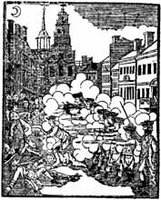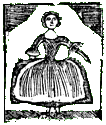The First Day of Testimony Against the Soldiers
He testified about how Pvt. Hugh White conked him on the head for speaking rudely about a passing army captain.
Edward’s testimony might have been more useful in prosecuting White, showing he had was aggressive and violent toward locals before anyone threatened him. But the prosecutors at the soldiers’ trial never called the boy, and we have no indication why.
Instead, the Crown’s opening witness on 27 Nov 1770 was “Jonathan Williams Austin, clerk to John Adams, Esq.” Which is to say, an assistant and trainee of the senior defense counsel.
By modern standards, this is a clear conflict of interest. But Austin had already testified for the Crown at the Preston trial. Even though the captain was acquitted, prosecuting attorneys Robert Treat Paine and Samuel Quincy must have felt the law clerk was a solid witness because they brought him back.
“Do you know either of the prisoners at the bar?” Quincy asked as his first recorded question.
Austin replied that he recognized Pvt. William Macauley: “I was about four feet off: McCauley said ‘Damn you, stand off,’ and pushed his bayonet at me: I did so.” After the shots, Austin recalled, he saw Macauley reload.
The prosecutors asked the next two witnesses, merchant Ebenezer Bridgham and James Dodge, the same first question, and similar questions of town watchman Edward G. Langford and clerk Francis Archbald. The attorneys’ goal was to establish that the defendants were definitely among the soldiers on King Street, and hopefully among those who fired at the crowd. Thus:
- Bridgham said he saw a tall soldier he thought was Pvt. William Warren fire his gun, but didn’t see Cpl. William Wemms do so.
- Dodge named Warren and White as present, and said the first shot came from the left side of the squad.
- Langford identified White and Pvt. Mathew Kilroy, also said the first shot came from the left side, and testified that “immediately after Kilroy’s firing” ropemaker Samuel Gray fell dead, and “there was no other gun discharged at that time.”
- Archbald also testified to Kilroy’s presence.
Here are some vivid details from the exchanges.
Q. Was you looking at the person who fired the last gun?At five o’clock, the judges adjourned until the next morning. Since most trials of the time were over in a day, that was unusual, but—after Capt. Preston’s trial—not unprecedented.
A [from Bridgham]. Yes, I saw him aim at a lad that was running down the middle of the street, and kept the motion of his gun after him a considerable time, and then fired.
Q. Did the lad fall?
A. He did not, I kept my eye on him a considerable time.
Q. Was the snow trodden down, or melted away by the Custom-House?
A [from Dodge]. No, the street was all covered like a cake.
A [from Langford]. Samuel Gray…came and struck me on the shoulder, and said, Langford, what’s here to pay.
Q. What said you to Gray then?
A. I said I did not know what was to pay, but I believed something would come of it by and bye. He made no reply. Immediately a gun went off. . . . I looked this man (pointing to Killroy) in the face, and bid him not fire; but he immediately fired, and Samuel Gray fell at my feet.
A [from Archbald]: I saw a soldier, and a mean looking fellow with him, with a cutlass in his hand: they came up to me: somebody said, put up your cutlass, it is not right to carry it at this time of night. He said, damn you ye Yankee bougers, what’s your business:






